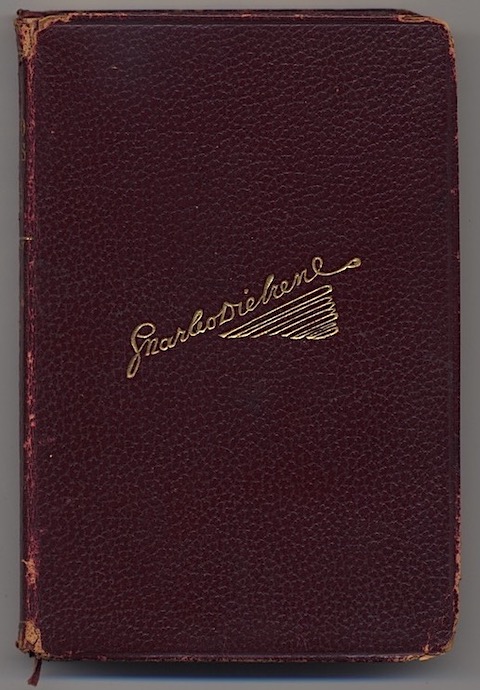Snarbodiehene... Jnarbodiehens... oh heck, I give up! It must be some durned foreign language.
Err--wait. Hold on a sec'... I've got it now!
It's charlesdickens, or rather, Charles Dickens! It's his exact signature to be precise, or an interpretation of his signature by this particular publisher.
Ha! It can't be anybody else. It's embossed on the cover of one of his most famous books, A Tale of Two Cities. Clearly I was having one of those static gray-cell moments that we all fear as we get older. But man, you have to admit, that's one loopy signature.
This edition was published by the John C. Winston Company of Philadelphia, circa 1915, although the illustrations are dated 1905 (that's probably because Collins Clear Type Press of London published this book first, while also commissioning the illustrations). It's bound in cordovan colored leather, letter embossed, and it has a silk ribbon and gilt top-edge. It measures 6 x 4 inches, which means it's pretty small, the size of a vintage paperback, making it ideal for collecting.
The title page decoration above was done by Malcolm Patterson, but all of the other interior illustrations, seen below, were created by a different artist, one who signed as A. A. Dixon.
Arthur Augustus Dixon was born in London, England, in 1872. He trained at the Camden School of Art, and he was only 24 years old when he had his first exhibition, one of several it would seem, at the Royal Academy of Art. He also exhibited at the Royal Society of British Artists.
Dixon became primarily a book illustrator in his native country, and apparently a prolific one, producing covers and interiors for five decades. His first commission came from Ernest Nister in 1899, for The Holly Tree by Charles Dickens. Among his other publisher clients were Blackie & Sons, Collins Clear Type Press, Cassell & Co., James Nisbet & Co., Raphael Tuck & Sons, and in America in conjunction with Collins the John C. Winston Company. In addition to scores of children's books, he also illustrated dozens of Collins' re-issues of classic works by famous authors such as Jane Austen, Alexander
Dumas, Nathaniel Hawthorne, Oliver Wendell Holmes, Victor Hugo, John
Keats, Lord Lytton and Alfred Tennyson.
The Dictionary of British Book Illustrators of the Twentieth Century described Dixon's artwork as thus: "His book illustrations, mainly in full colour or half tone, were conventional and prosaic with sentimental overtones, but generally competent."
I suppose there are worse things to be called than conventional and competent. Dixon died in Berkhamsted, Hertfordshire in 1959, at the ripe old "conventional" age of 87.















BELOW are a few examples of Dixon's artwork in color. Curiously, whether by choice, circumstance or simple availability, religious themes and subject matter tended to dominate his assignment taking, especially from about 1914 onward.
 |
The Precious Gift, Bible Stories for Children. Theodora Wilson. Blackie, 1916
|
 |
Jesus and the Blind Man. Date unknown, possibly from The Precious Gift
|
 |
Children's Stories from Shakespeare. Raphael Tuck, 1919
|
 |
David Copperfield. Charles Dickens. Collins Clear Type, 1920
|
 |
Moses and the Promised Land. Theodora Wilson. Blackie, 1922
|
 |
Tales of the Alhambra. Washington Irving. Raphael Tuck, 1924
|
 |
Tales of the Alhambra. Washington Irving. Raphael Tuck, 1924
|
 |
In His Footsteps. Theodora Wilson. Blackie. Date unknown
|
 |
Mother and Child. Date unknown
|
 |
The Visitation. Date unknown
|

I SUPPOSE most of us amateurs have drawn a religious scene or two while sittin' at the drawing table. There's just something inherently calming about composing such serene pictures. I drew the one you see above, a pastel that got inadvertently folded and wrinkled during storage, way back in high school. Not my best drawing by any means, and made worse by the halo. Sheesh! What was I thinking? Oh yeah--I was having calm, peaceful thoughts. Something our world could use a lot more of these days.
So, if my man Arthur A. Dixon was deemed merely "competent" by scholars in his own
field, how bad are the rest of us, that is, we amateurs? Ha! I'm sure I don't really want to know!
PEACE OUT
[© June, 2024, Jeffersen]





























No comments:
Post a Comment